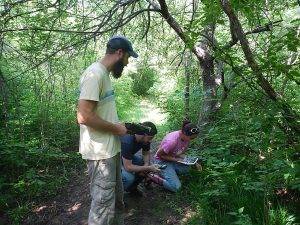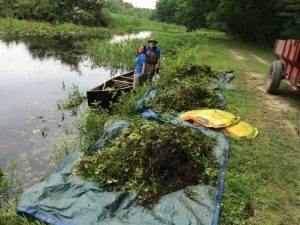
Partnering to Protect Western New York from Invasive Species
Western New York Partnership for Regional Invasive Species Management (WNY PRISM) is one of eight regional public-private partnerships created to address the threat posed by invasive species. WNY PRISM is focused on improving the effectiveness of invasive species management and increasing awareness of invasive species issues within our eight-county region.
The WNY PRISM region includes the eight westernmost counties in New York State: Allegany, Cattaraugus, Chautauqua, Erie, Genesee, Niagara, Orleans and Wyoming. This region is home to some of New York’s most impressive natural features such as Niagara Falls and the Niagara River Gorge, Letchworth State Park, Zoar Valley, and the shorelines of both Lake Erie and Lake Ontario. Land dedicated to agriculture includes over 1.4 million acres, and the region holds a population of over 1.55 million residents.
The WNY PRISM mission is to proactively identify, evaluate and address invasive species priorities in western New York using a coordinated partnership of local professionals, organizations and private citizens to improve, restore and protect local aquatic and terrestrial resources.
Core Functions & Goals
Partner/Network Coordination
Establish a partnership network and communication for those involved in invasive species information and management within the WNY PRISM region. Facilitate opportunities for cooperation including sharing of information, personnel, equipment and expertise.
Information Management
Collect, utilize, and share information regarding invasive species management including species, pathways of invasion, surveys, infestations, control methods, monitoring, research, current efforts/projects and opportunities for partner collaboration.

Education and Outreach
Increase the public, partner, and stakeholder awareness, understanding and participation in invasive species issues and management within the WNY PRISM region, through effective educational and outreach efforts.
Prevention
Facilitate the prevention of new occurrence, spread, and further establishment of invasive species within the WNY PRISM region through understanding of pathways of invasion and targeting of priority conservation areas. Prevention measures must address both the movement of invasive species in and out of the WNY PRISM region.
Early Detection and Rapid Response
Develop effective early detection, assessment and rapid response protocol(s) for the WNY PRISM region including mapping procedures, volunteer training/involvement, Best Management Practices, permit regulations and response teams, and provide assistance to partners for implementation of recommended protocols.
Management and Habitat Restoration
Assist partners with control of invasive species (eradication, containment, suppression) on high priority conservation areas based on identified regional conservation targets. Assist with the establishment of long-term management and monitoring, and the restoration of impacted sites to healthy native vegetation, to provide increased resilience against future invasions.
Invasive Species Priorities
WNY PRISM developed regional priority species through our Terrestrial and Aquatic Invasive Species Working Groups in 2015.
Terrestrial Priorities
- Adelges tsugae Hemlock Wooly Adelgid
- Agrilus planipennis Emerald Ash Borer
- Cirsium arvense Canada Thistle
- Cynanchum louiseae Black Swallow-wort
- Cynanchum rossicum Pale Swallow-wort
- Lonicera spp. Bush Honeysuckles
- Phalaris arundinacea Reed Canary Grass
- Phragmites australis Phragmites, Common Reed
- Reynoutria spp. Knotweeds
- Rhamnus cathartica Common Buckthorn
Aquatic Priorities
- Corbicula fluminea Asian Clam
- Hemimysis anomala Bloody Red Shrimp
- Hydrilla verticillata Hydrilla
- Hydrocharis morus-ranae European Frog-bit
- Orconectes rusticus Rusty Crayfish
- Scardinius erythrophthalmus Rudd
- Trapa natans Water Chestnut
Early Detection Priorities
- Anoplophora glabripennis Asian Longhorned Beetle
- Brachypodium sylvaticum Slender False Brome
- Channa argus Northern Snakehead
- Eichhornia crassipes Water Hyacinth
- Hypophthalmichthys molitrix Silver Carp
- Hypophthalmichthys nobilis Bighead Carp
- Microstegium vimineum Japanese Stiltgrass
- Persicaria perfoliata Mile-a-Minute Vine
- Pistia stratiotes Water Lettuce
For more information, please contact WNY PRISM at 716-878-4708 / wnyprism@buffalostate.edu.
Website



